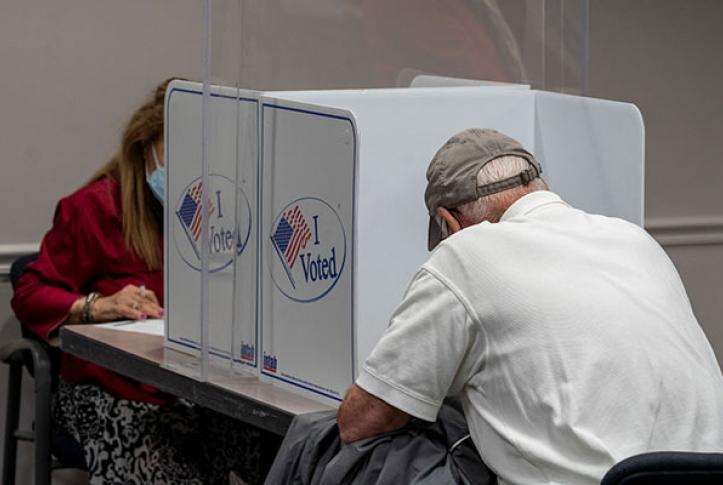Survey Highlights
- In considering which health care issues will matter most in their vote for president, likely voters were split nearly evenly on two: addressing the public health needs and economic costs of COVID-19 (40%) and protecting insurance for people with preexisting health conditions (39%). A third issue, lowering the cost of health care, was the most important factor for 20 percent of voters.
- A majority of voters in nine of 10 battleground states said Former Vice President Joe Biden is the more likely of the two candidates to address both COVID-19 and its economic costs. In Ohio, President Trump has the edge on the issue (48% vs. 45%), but the gap between the two candidates was within the margin of error.
- In each of the 10 battleground states, a majority of likely voters said Biden is more likely to protect insurance coverage for people with preexisting conditions. Likely voters favor Biden over Trump on this issue by between 6 percentage points in Ohio to 33 percentage points in Georgia.
- Fewer than half (48%) of likely voters said they would feel very safe voting in person if the election were held today. Just one-third are very confident that people who vote by mail will have their vote counted.
With the 2020 presidential election just weeks away, the Commonwealth Fund polled U.S. adults about which of three health care issues would matter most in their vote and about which candidate — President Donald Trump or Former Vice President Joe Biden — they think is more likely to address each of them. Between August 25 and September 20, 2020, the survey research firm SSRS interviewed 7,442 adults age 18 and older, including 5,655 likely voters. In 10 battleground states 5,493 adults were polled, including 4,220 likely voters. Among likely voters, the survey had an overall margin of error of +/– 1.9 percent. The margin of error in battleground states among likely voters was: Arizona (+/– 6.7%), Florida (+/– 6.3%), Georgia (+/– 6.1%), Michigan (+/– 6.1%), Minnesota (+/– 6.8%), North Carolina (+/– 6.4%), Ohio (+/– 6.5%), Pennsylvania (+/– 5.7%), Texas (+/– 6.7%), and Wisconsin (+/– 7.3%).
Which Health Care Issue Will Factor Most in Your Vote?
The poll asked likely voters how important a factor in their vote for president the following issues are:
- The ability of the candidates to address both the public health needs and economic costs of COVID-19.
- The likelihood they will protect health insurance coverage for people with preexisting health conditions.
- The likelihood they will lower the cost of your health care.
Excluding the 9 percent of likely voters who said that none of these issues would be a factor in their vote,1 we asked people to choose the issue most important to them in voting for a candidate.
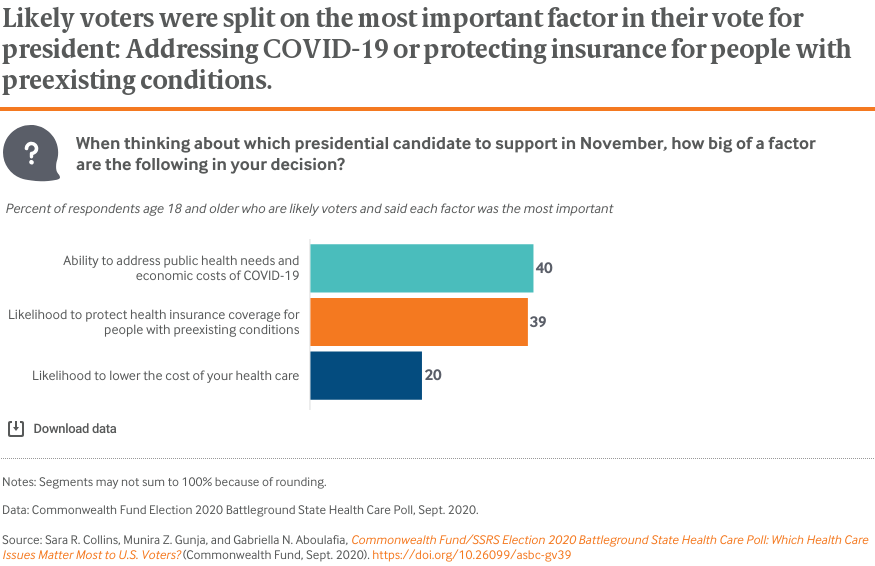
More than half of likely voters said that COVID-19 and preexisting conditions are very important factors in their choice of president, with two of five saying that lowering their health care costs is very important (data not shown). When asked to choose the most important factor, respondents were split nearly evenly between COVID-19 (40%) and preexisting condition protections (39%); lowering health care costs is the most important factor for 20 percent of likely voters.
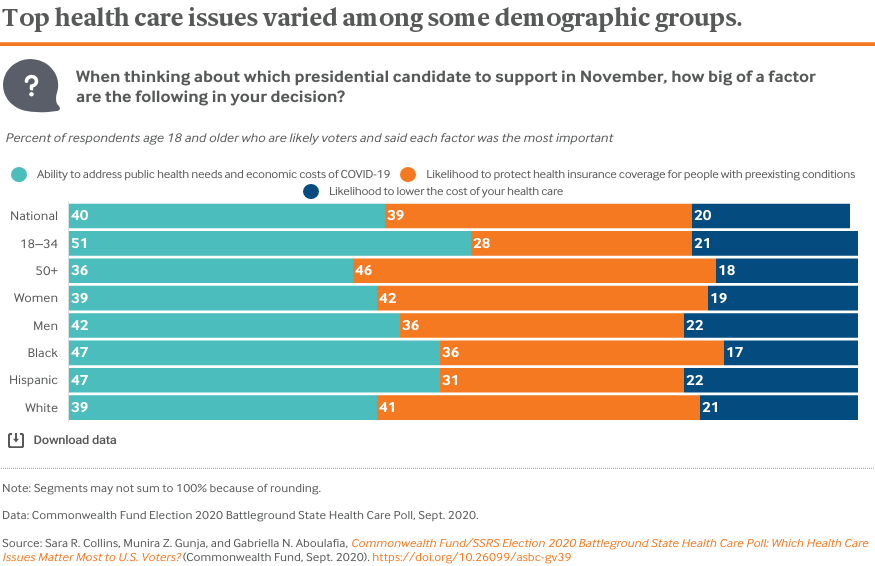
Nationally, there were some notable differences by age, gender, and race and ethnicity as to which of the three factors is most important.
Likely voters under age 35 (51%) were more likely than voters age 50 and older (36%) to choose COVID-19 as the most important factor in their vote. Black (47%) and Hispanic (47%) likely voters were also more likely to say COVID-19 relative to white (39%) likely voters.
Likely voters age 50 and above (46%) were more likely than those under age 35 (28%) to choose preexisting condition protections as the most important factor in their vote, as were women (42%) more likely than men (36%).
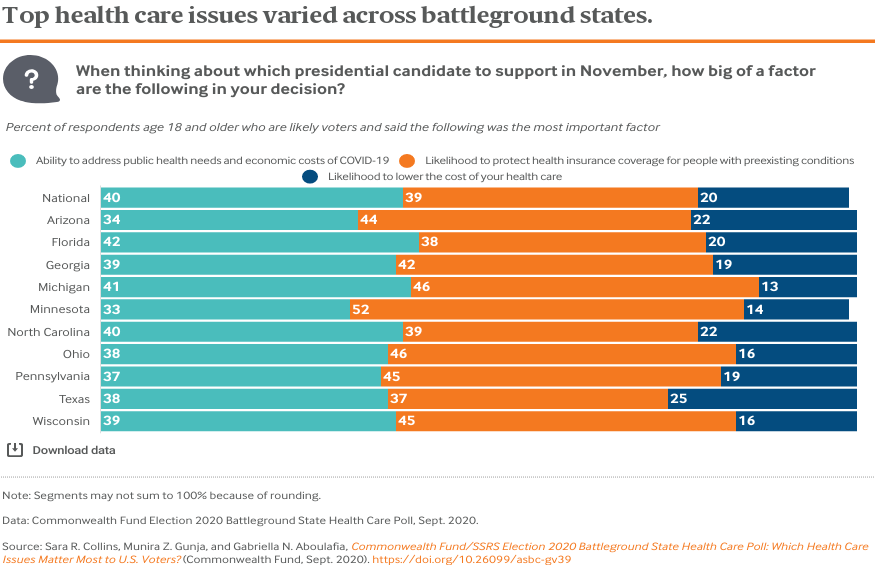
Across the 10 battleground states there are also a few notable differences.
Similar to the nation as a whole, likely voters in many of the 10 battleground states were split between COVID-19 and preexisting conditions as the most important issue in their vote for president. But in six states (Arizona, Michigan, Minnesota, Ohio, Pennsylvania, and Wisconsin), the ability of the president to protect insurance for people with preexisting conditions is the most important issue by a margin of at least 5 percentage points relative to COVID-19.
Is Trump or Biden More Likely to Address Key Health Care Concerns?
We next asked Americans, based on what they had heard so far, which of the two candidates is more likely to address the three issues we asked about.
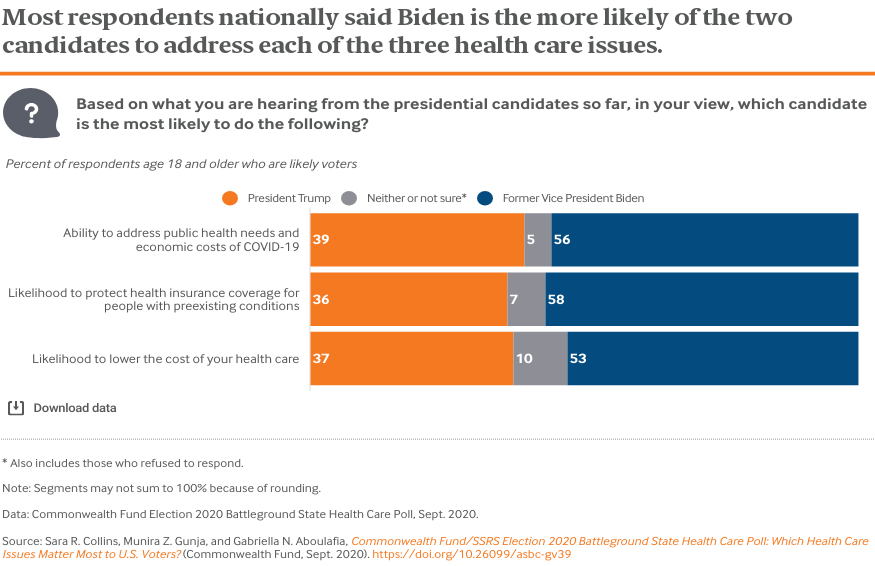
Nationally, more than half (53%–58%) of respondents said Biden is the one more likely to address each of the issues; 36 percent to 39 percent said Trump. Biden also led on each issue among all demographic groups, except among Republican likely voters. But there was variation.
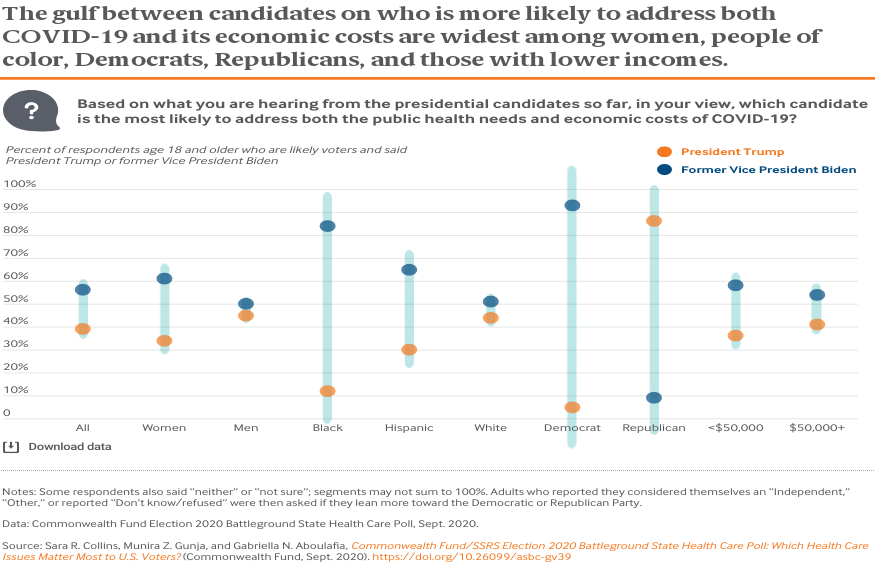
On the issue of who would be more likely to address both COVID-19 and its economic costs, women side with Biden by a margin of nearly 2 to 1 (61% vs. 34%). The gap between men on the two candidates is closer (50% vs. 45%).
Black respondents support Biden by a margin of 7 to 1 (84% vs. 12%), Hispanic respondents by more than 2 to 1 (65% vs. 30%). Among white respondents, the candidates are closer on this issue (51% vs. 44%).
Republicans and Democrats were polar opposites on which candidate is more likely address this issue.
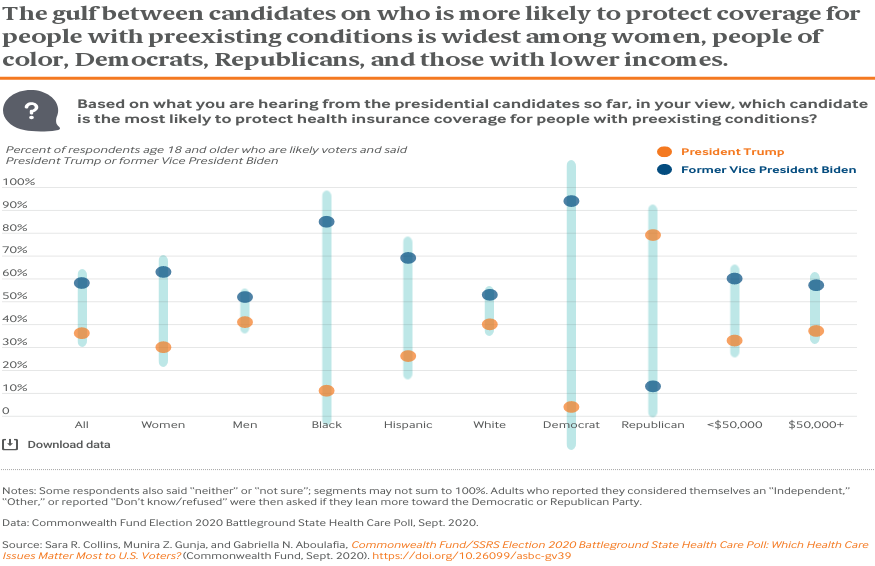
On the question of which candidate is more likely to protect insurance for people with preexisting health conditions, the gulf between Biden and Trump was as wide, or wider, among all demographic groups as it was for COVID-19 — with the exception of Republicans, where the difference was narrower. Gaps were wider among both women and men, Hispanics and whites, and those with incomes under and over $50,000.
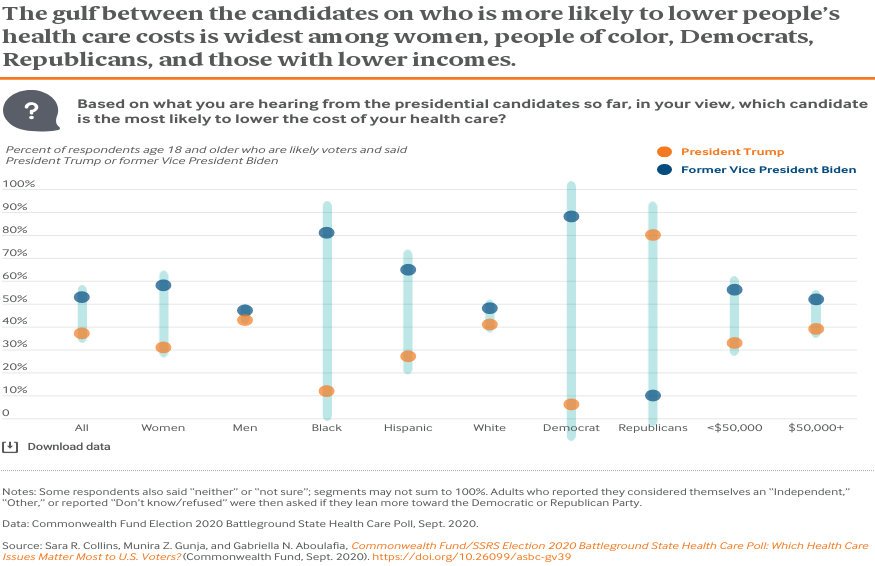
Response patterns were similar for the question of which candidate is more likely to lower people’s health care costs. The narrowest gaps between the two candidates were among men and whites.
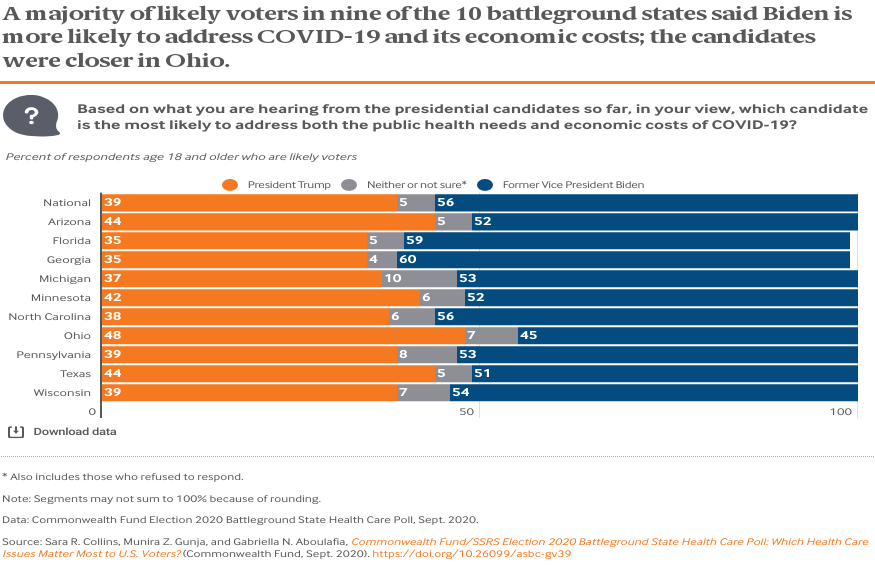
In the 10 battleground states, Biden led Trump on the issue of preexisting conditions in each state, as well as in nine of the 10 states on the issues of COVID-19 and health care costs. But, again, there was variation.
Looking at the public health needs and the economic costs of COVID-19, a majority of voters in every state but Ohio said Vice President Biden was the more likely of the two candidates to address both. In Ohio, President Trump had the edge on the issue (48% vs. 45%), but the gap between the two candidates was within the margin of error. Biden’s lead over Trump on the issue was widest in Florida (59% vs. 35%) and Georgia (60% vs. 35%) and narrowest in Texas (51% vs. 44%), which was within the margin of error.
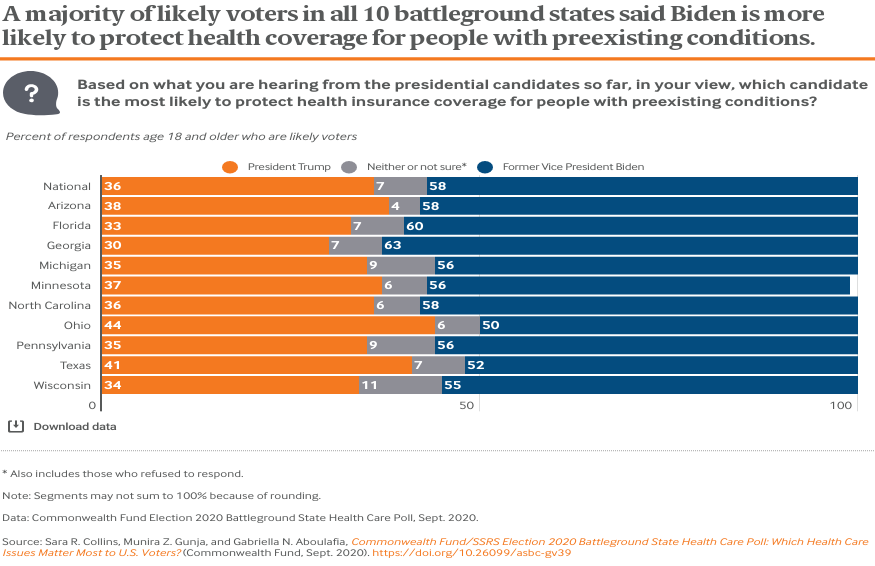
In each of the 10 battleground states, a majority of likely voters said Biden was more likely to protect health coverage for people with preexisting conditions. Ohio was the only battleground state where the margin between Biden and Trump was less than 10 percentage points. In Florida and Georgia, likely voters viewed Biden more favorably than Trump on the issue by 27 and 33 points, respectively.
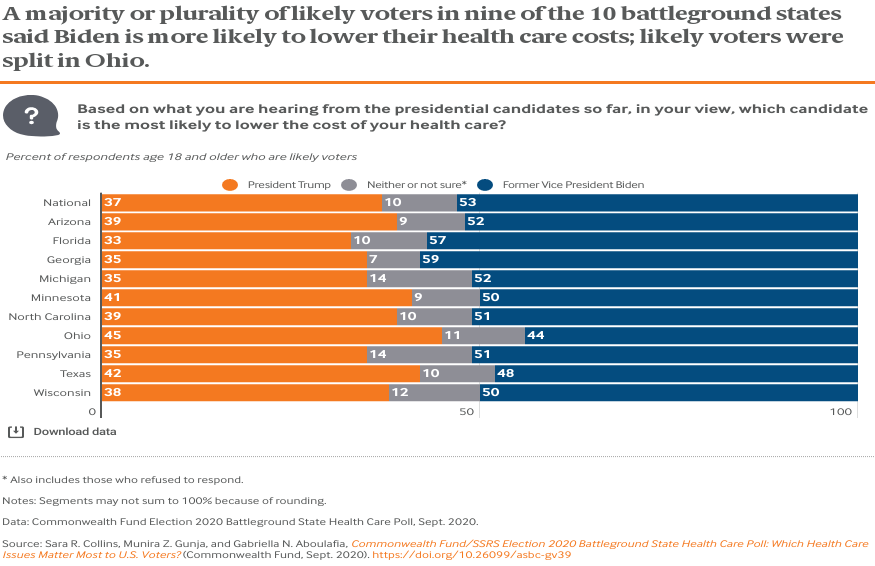
A majority or plurality of likely voters in nine of the 10 battleground states viewed Biden as more likely to lower their health care costs. Likely voters were split in Ohio: 45 percent said Trump is more likely to lower their costs, compared to 44 percent who said Biden is. Biden’s lead over Trump in the nine states on this issue was widest in Florida (57% vs. 33%) and Georgia (59% vs. 35%) and narrowest in Texas (48% vs. 42%).
How Safe Do Americans Feel About Voting in Person This Fall?
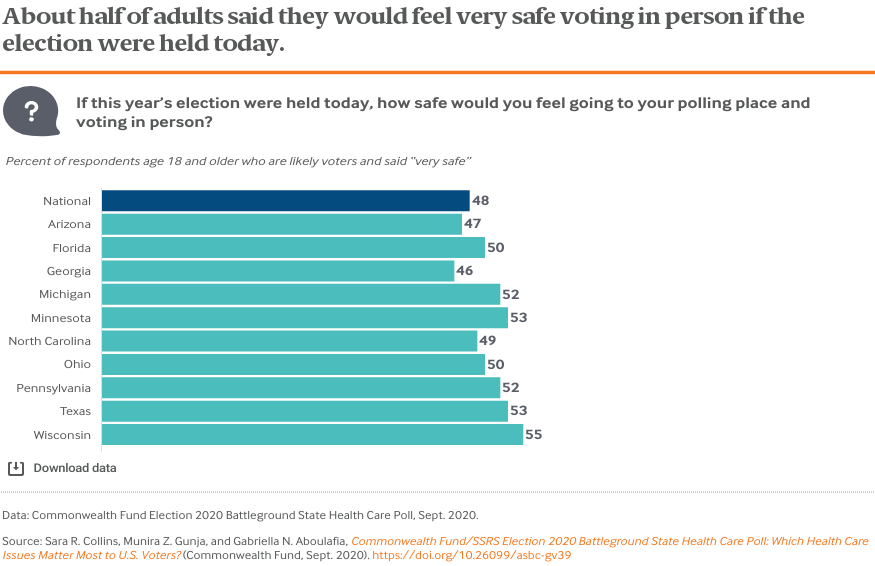
Just under half (48%) of likely voters said they would feel very safe voting in person if the election were held today; 30 percent said they would feel somewhat safe (data not shown). There was some variation across battleground states on this issue, ranging from 46 percent in Georgia to 55 percent in Wisconsin.
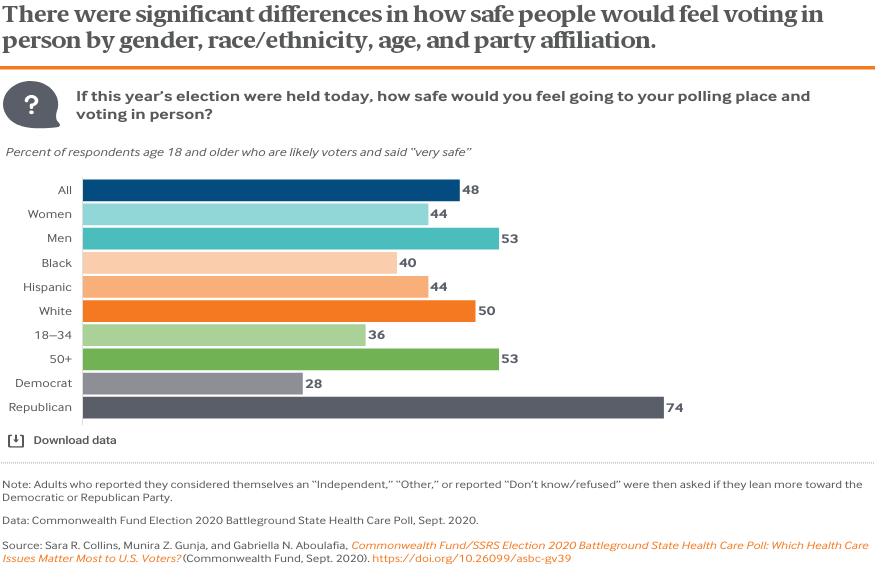
There were also some differences among likely voters by demographics. Women, Blacks, younger respondents, and Democrats were significantly less likely to say they felt very safe voting in person compared to men, whites, people age 50 and older, and Republicans.
Likely Voters Have Very Little Confidence in Voting by Mail
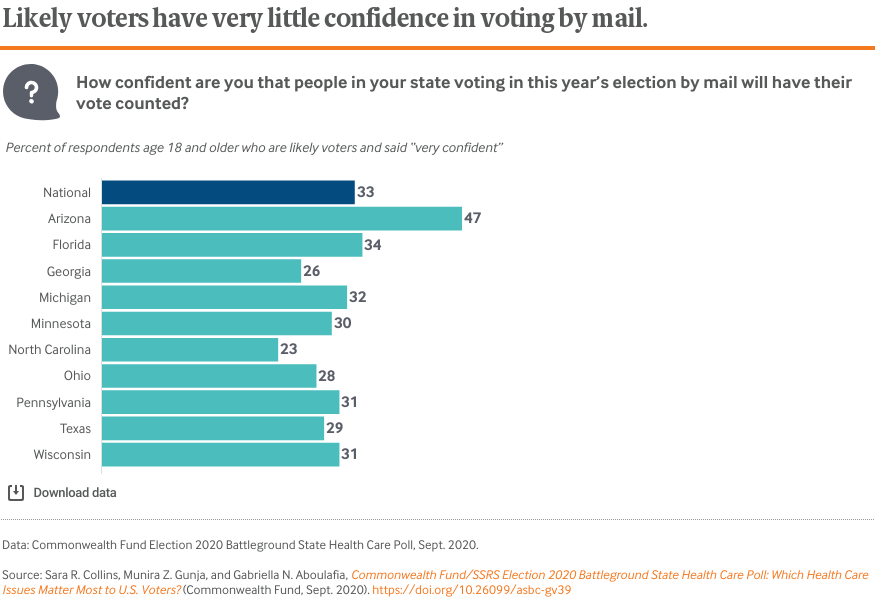
All 50 states and the District of Columbia will allow people to vote by mail this fall. However, a few states, including Texas, will require a valid excuse other than the novel coronavirus pandemic.
Only one-third of voters said they are very confident that people who do vote by mail will have their vote counted; 31 percent said they are somewhat confident. There was little variation by demographic group, other than age and party affiliation: 44 percent of likely voters age 65 and older are very confident, compared to about half that share (23%) among likely voters under age 35 (data not shown). Only a quarter (27%) of Republicans are very confident that votes cast by mail would be counted, compared to just over one-third (38%) of Democrats.
In the battleground states, likely voters who are very confident that mailed-in votes would be counted ranged from a low of 23 percent in North Carolina to a high of 47 percent in Arizona.
Conclusion
More than 200,000 people in the United States have died from COVID-19, and more than 13 million are currently unemployed. Not surprisingly, addressing both the health and economic aspects of the pandemic was a top-ranked health care issue that respondents to our survey said would matter most in voting for president this fall.
A majority of likely voters nationally and a majority in nine of 10 battleground states viewed Former Vice President Biden as more likely than President Trump to address the issue. More likely voters sided with Trump on this issue in Ohio, but the difference with Biden was within the margin of error.
Protecting insurance coverage for people with preexisting health conditions was a top issue in the 2018 midterm elections, and this survey indicates that it continues to be very important to people nationally and in battleground states. The Affordable Care Act (ACA) currently provides this protection. Trump supports the case now pending before the Supreme Court that would overturn the ACA and its preexisting conditions provisions. The president has said he will have a plan that offers this protection but has yet to put one forward.
Biden, meanwhile, pledges to support and build on the ACA, keeping its preexisting condition protections intact. Nationally, and in all 10 battleground states, he is viewed by a majority of likely voters as the candidate more likely to protect coverage for people with preexisting conditions. Only in Ohio does Trump come within 10 percentage points of Biden on this issue.
The pandemic has left many Americans fearful of voting in person this fall. Likely voters who were female, Black, under age 35, or identified as Democrats were significantly less likely to say they would feel very safe voting in person than those who were male, white, age 65 and older, or identified as Republicans.
Meanwhile, although voters in most states will have the option of voting by mail this fall if they fear the virus, only one-third nationally and one-third or fewer in most battleground states are very confident that votes cast by mail will be counted.
How We Conducted This Survey
The Commonwealth Fund Election 2020 Battleground State Health Care Poll was conducted by SSRS from August 25 through September 20, 2020. The survey consisted of telephone interviews conducted among a random sample of 7,442 adults, age 18 and older, living in the United States. The study included an oversample of adults in 10 battleground states. The final weighted sample is nationally representative of adults, ages 18 and older, and statewide samples were weighted to be representative of adults in each state.
Overall, 2,229 interviews were completed via landline and 5,213 were conducted via mobile phone. The margin of error for the study was +/– 1.7 percentage points. For this analysis, the sample population was limited to adults who reported they would definitely vote in the 2020 Presidential election (“likely voter”). The final sample size among likely voters was 5,655, with a margin of error of +/– 1.9 percentage points. The final sample of likely voters in each battleground state was:
State
Sample size
Margin of error (%)
Arizona
416
6.7
Florida
424
6.3
Georgia
417
6.1
Michigan
444
6.1
Minnesota
417
6.8
North Carolina
428
6.4
Ohio
430
6.5
Pennsylvania
451
5.7
Texas
374
6.7
Wisconsin
419
7.3
This is the second poll in a series to track public sentiment on a range of health care issues during the 2020 Presidential election season. Respondents in all states were reached through the weekly SSRS Omnibus survey. Additional interviews in the 10 battleground states were completed through callbacks to respondents who completed surveys on the SSRS Omnibus. The SSRS Omnibus uses a dual-frame random digit dial (DFRDD) sample design.
The data were weighted to provide nationally representative and projectable estimates of the adult population, age 18 and older, in each battleground state and in the country as a whole. The weighting process takes into account the different probabilities of respondent selection, based on telephone usage and household composition. An adjustment was also made to correct for the disproportionate stratification of the SSRS Omnibus callback sample.
The sample was post-stratified and balanced by key demographics such as age, race, sex, region, education, and telephone usage. Each battleground state, and the rest of the country, was weighted separately, then combined. A final weighting adjustment was made to put the battleground states into their proper proportions.
The average overall response rate for those reached through the SSRS Omnibus is 4 percent. For the SSRS Omnibus callback sample, the landline portion of the survey achieved a 31 percent response rate and the cellular phone component achieved 20 percent response rate, yielding an overall response rate for the callback sample of 1 percent.
Acknowledgments
The authors thank Robyn Rapoport, Sarah Glancey, Christian Kline, and Erin Czyzewicz of SSRS; and David Blumenthal, Liz Fowler, Rachel Nuzum, Eric Schneider, Laurie Zephyrin, Michelle Doty, Reginald Williams, Barry Scholl, Chris Hollander, Jen Wilson, Paul Frame, Bethanne Fox, Naomi Leibowitz, and Jesse Baumgartner, all of the Commonwealth Fund.
